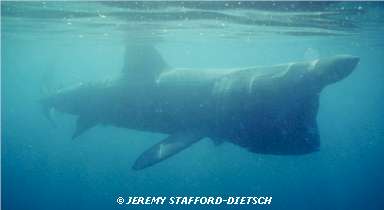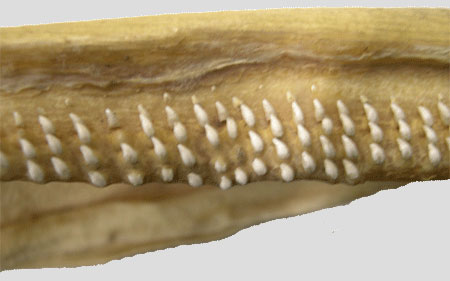Rocky Reefs: Rich Feeding in Cool Waters
Basking Shark
Seen only at certain times of the year, Basking Sharks (Cetorhinus maximus) are hard to miss when they appear at the surface in coastal areas. The huge, sail-like dorsal fins of these enormous, ponderous-swimming sharks are readily visible from distances up to several miles (kilometres).
Just the Facts:
Size:
Reproduction:
Diet:
Habitat: Rocky Reefs, Deep Sea?, Polar Sea Depth: surface to at least 300 ft (100 m), possibly to 1640 ft (500 m) or more Distribution: Arctic, Temperate Eastern Pacific, Tropical Eastern Pacific, Chilean, Western North Atlantic, Caribbean, Argentinean, Eastern North Atlantic/Mediterranean, Southern African, South East Asian, Western Australian, Southeast Australian/New Zealand, Japanese |
Traditionally, the seasonal appearance of Basking Sharks was a reliable time to harpoon these gigantic sharks for food, leather, and liver oil. Some of these fisheries also generated an unexpected ‘bonus’: a great deal of basic biological information about Baskers was collected. But centuries of concentrated harvesting off the shores of many countries have left Basking Shark populations much depleted. Entanglements in commercial fishing gear also took their toll of Basking Shark lives. The resultant economic loss was deemed so severe off British Columbia, Canada, that between 1955 and 1956 the bow of a government vessel was outfitted with a huge steel blade which was used to kill more than a hundred of the ‘problematic’ Baskers by neatly slicing them in two — up to 36 individual sharks a day were killed in this manner. In consequence of such commercial harvesting and eradication programs, few Baskers are seen each year in places where they were formerly abundant.
Basking Sharks can still be seen seasonally in certain places. For example, from June to early September, aggregations of 3 to 40 or more Baskers appear in surface waters off the Isle of Man, in the heart of the Irish Sea. Since 1980, a concentrated Basking Shark research effort has been underway here and a small, seasonal eco-tourism industry has developed. Sometimes these two interests combine, with tourists eagerly assisting the researchers’ efforts through tagging, taking measurements, and making specific observations. Similar on-going studies are being conducted off the east and west coasts of Canada. Studies such as these provide fascinating details of Basking Shark feeding, movement patterns, and social behavior.
Baskers are unusual among sharks in that they are gigantic filter-feeders. They feed by swimming slowly with their huge, hoop-like jaws agape and enormous gill slits billowed out, spinnaker-like. Tiny planktonic animals are strained from the water via bristle-like gill rakers that are actually greatly enlarged dermal denticles. Every 30 to 60 seconds, a feeding Basker closes its mouth and flutters its gills, apparently to dislodge and swallow the plankton trapped by its gill rakers. It is astonishing that Baskers — the second-largest of all sharks — can grow to titanic size by feeding on such tiny, patchily distributed prey.
Basking Shark feeding behavior is the subject of extensive on-going studies off Plymouth, southwestern England. Here, Baskers more than 10 feet (3 metres) in length appear in surface waters directly after the increase in zooplankton density that occurs each May, while young-of-the year Baskers less than 10 feet in length appear later in the summer when plankton concentrations are lower. No Basking Sharks are seen after July, when zooplankton density is least.
How do Basking Sharks locate their planktonic food? Recent studies off Plymouth revealed that Baskers preferentially seek out concentrated patches of relatively large zooplankters that occur along thermal fronts, places where water masses of different temperature meet. We know almost nothing about temperature sensors in sharks and whether Baskers can obtain a sense of relative plankton concentrations from tactile stimulation of its gill rakers is unknown. However, like other sharks, Baskers almost certainly have a well-developed sense of smell. They may therefore locate rich patches of zooplankton chemically. A likely chemical cue is an organic compound called “dimethyl sulfide”, a powerfully smelly molecule that is released by phytoplankton (tiny drifting plants, such as diatoms) as they are fed upon by copepods and other large, predatory zooplankton. This chemical cue is known to be used by a wide variety of planktivores, including copepods and albatrosses, and it seems likely that the Basking Shark would make use of it, too. But this remains to be tested.

Photo © Jeremy Stafford-Deitsch;
used with the gracious permission of the photographer,
who asks that you support
the Shark Trust.
Basking Sharks were recently studied in Clayoquot Sound, British Columbia. Over a 20-year period, 27 individual Baskers were identified on the basis of photographs of their dorsal fins but only 6 were re-sighted, indicating that the resident population in the Sound is quite small. Seen alone or in groups of two or three, the sharks are most likely to be seen between March and October, during sunny, calm weather, and in early morning or late afternoon. Some Baskers were observed leaping completely out of the water — which is astonishingly athletic for a fish whose mass is calculated in tons (tonnes). Many of the Baskers have deep scars on the dorsal fin and snout, apparently caused by boat propellers. During the study period, three Baskers became tangled and died in commercial fishing gear.
Another study examined incidental catches of Basking Sharks in commercial fishing gear in coastal waters off Newfoundland, Canada. Between 1980 and 1983, no fewer than 371 Baskers were caught here in inshore fishing gear, mostly in salmon gillnets and cod traps set between the surface and a depth of 130 feet (40 metres). Nearly 70% of the entangled Baskers were males, which tend to be caught earlier in the fishing season than the females. This heavy sex-bias is consistent with commercial catches of this species off the United Kingdom, which have found male-to-female ratios of 30 or 40 to one. Such a predominance of males probably indicates sexual segregation in Basking Sharks. Over the four-year study period, only nine immature Basking Sharks were caught — representing less than 2.5% of the total number of captures — suggesting that the usual summer distribution of adult male Baskers is distinct from that of juveniles.
Juvenile Basking Sharks offer yet another mystery: they have a peculiar elongated snout tip that looks remarkably like a wavy carrot. In some individual Baskers the carrot-tip waves upward, in others downward. This peculiar snout shape disappears by the time a Basking Shark reaches a length of about 16 feet (5 metres). A recent study examined the rostral (snout) cartilages of an 8.5-foot (2.6-metre) female Basker from Japanese waters. It revealed that the undersurface of the snout of a juvenile Basker has a groove that is continuous with the palate. This groove becomes very faint in specimens longer than about 10 feet (3 metres) and disappears completely by a length of 30 feet (8.5 metres). This grooved, elongated snout may help channel food into the mouth of very young Basking Sharks. Like other lamnoid sharks, Baskers supplement their diet during fetal development by imbibing a thick ‘soup’ containing thousands upon thousands of tiny, unfertilized eggs produced by the mother. The grooved, elongated snout may help channel these eggs into the mouths of fetal Baskers as they develop in their mother’s womb. Therefore, the peculiar snout of near-term and new-born Basking Sharks may help support their energy needs during their period of most rapid growth.

Basking Shark tooth bed, showing multiple rows of tiny teeth
One of the most perplexing of Basking Shark mysteries concerns their seasonal absence from surface waters during winter. When plankton numbers decline in the late fall, Baskers virtually disappear. The few Basking Shark specimens caught at this time of year have apparently shed their gill rakers, which are presumed to be absolutely vital to their filter-feeding mode of life. About 45 years ago, a well-respected expert on Basking Sharks calculated that, in British seas at peak plankton concentrations during late summer and autumn, Baskers manage to strain from the water barely enough calories to recoup the energy expended in collecting it. It was therefore speculated that Basking Sharks shed their gill rakers in winter and hibernate on the bottom until plankton numbers rise in the spring to worthwhile levels.
A recent paper re-examined these calculations in light of refined models of Basking Shark hydrodynamics and more accurate data on the precise caloric value of the planktonic organisms on which they feed. The calculations reveal that Baskers are more efficient swimmers and can gain energy at much lower plankton concentrations than had long been thought. In fact, these new calculations suggest that Basking Sharks are able to swim, maintain themselves, and grow even at the reduced plankton densities that occur during winter months. Therefore, Baskers are not energetically obligated to hibernate in winter. So why do Basking Sharks disappear in winter and where do they go?
I suspect that our traditional perception of Basking Sharks as surface-dwelling planktivores that, for some unknown reason, disappear in winter is almost completely backward. I propose that the so-called “Basking Shark” is actually a mesopelagic species (inhabiting the ‘twilight’ ocean layer that occurs between 330 to 3300 feet [100 to 1000 metres]) that seasonally develops gill rakers and invades the surface zone during summer and early autumn to take advantage of the rich filter feeding on plankton available in coastal waters at this time. My reasoning draws on several lines of evidence, including the reduced urea storage in the Basking Shark’s tissues, its long body cavity filled with an enormous liver, and the chemical composition of its liver oils. All these attributes are shared by many mesopelagic sharks and may thus represent a convergent adaptation to that environment. Since the Basker’s gill rakers are derived from dermal denticles which — like its teeth (degenerate though they may be) — are replaced continually, it would seem a relatively simple matter to develop them seasonally.

Basking Shark gill rakers
Invasion of surface waters in coastal regions may also create opportunities for Basking Sharks to interact socially. Leaping is a spectacular and energy-demanding activity that may have a social significance, or it may simply be a way to loosen skin parasites such as lampreys. Several Baskers are sometimes seen swimming in loose circles, lined up nose-to-tail like a submerged herd of circus elephants. We have no idea what this behavior might mean. The sharks may simply be circling to remain within a particularly rich patch of plankton.
However, a recent short paper suggests an intriguing alternate possibility. The paper describes parallel swimming and lazy circling in Basking Sharks as observed from the air off Nova Scotia, Canada. It features video stills that seem to show pairs of Baskers in direct contact. In some cases, one shark is seen following another with its nose pressed to its vent. In others, one shark is apparently nipping the pectoral fin of another and arching its body to bring their pelvic regions into contact. These behaviors are strongly suggestive of shark courtship and mating. Therefore, such circling aggregations of Basking Sharks may be engaged in activities vital to the perpetuation of their species and should not be interrupted.
Basking Shark Bibliography
More on: Biology of the Basking
Shark | Curiosity of Basking Sharks
Filter-feeding Elasmobranchs |
Large Size of Filter-feeders

